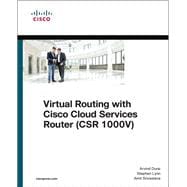The Cisco expert guide to planning, deploying, and operating virtual routing with the CSR 1000V Cloud Services Router
Virtual routing and the Cisco Cloud Services Router (CSR 1000V) are key enablers of today’s revolutionary shift to elastic cloud applications and low-cost virtualized networking. Now, there’s an authoritative, complete guide to building real solutions with the Cisco CSR 1000V platform.
Three leading experts cover every essential building block, present key use cases and configuration examples, illuminate design and deployment scenarios, and show how the CSR 1000V platform and APIs can enable state-of-the-art software-defined networks (SDN). Drawing on extensive early adopter experience, they illuminate crucial OS and hypervisor details, help you overcome migration challenges, and offer practical guidance for monitoring and operations.
This guide is an essential resource for all technical professionals planning or deploying data center and enterprise cloud services, and for all cloud network operators utilizing the Cisco CSR 1000V or future Cisco virtual routing platforms.
· Review the fundamentals of cloud virtualization, multitenant data-center design, and software-defined networking
· Understand the Cisco CSR 1000V’s role, features, and infrastructure requirements
· Compare server hypervisor technologies for managing VM hardware with CSR 1000V deployments
· Understand CSR 1000V software architecture, control and data-plane design, licensing requirements, and packet flow
· Walk through common virtual router scenarios and configurations, including multiple cloud and data center examples
· Integrate CSR 1000V into the OpenStack SDN framework, and use its APIs to solve specific problems
· Master a best-practice workflow for deploying the CSR 1000V
· Use the Cisco management tools to automate, orchestrate, and troubleshoot virtualized routing
Category: Networking/Cloud Computing
Covers: Cloud Services Router
This book is part of the Networking Technology Series from Cisco Press, which offers networking professionals valuable information for constructing efficient networks, understanding new technologies, and building successful careers








